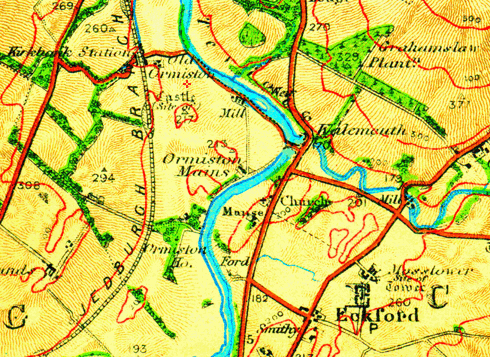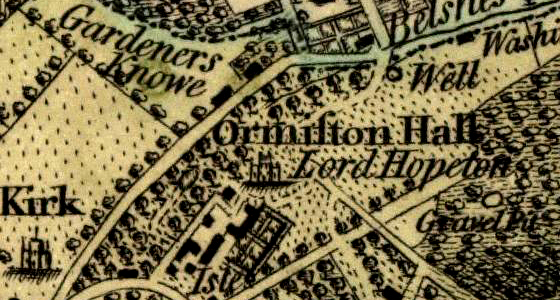

 |
|
Several miles south west of the present day village of Ormiston, close to the
famous yew tree where the reformer preacher John Knox delivered his volatile
sermons, sits the basement vaults of a late 15th century /early 16th century L-plan
keep of Ormiston castle. It is almost unrecognizable since it's decapitation,
absorption and cannibalization by other later 17th century and 18th century
buildings nearby, including the ruined Ormiston Hall (1748), which is often
mistaken to be the site of the original castle.
The castle was perched on a high ridge above the river valley on one side and possibly with ditches on the three other vulnerable sides. The site consisted of an L-plan keep with a 16th century lean-to addition and an enclosing wall with a gatehouse probably facing east towards the prosperous market town of Haddington. The lands of Ormiston were associated with two noble families, first the Dunbars who owned the land, then the Cockburns who built the castle. It also had links to the reformers George Wishart and John Knox. The Cockburns were originally vassal Lairds to the powerful Dunbar family, who held vast tracks of land and castles throughout the Lothian and Borders. The forefather of the Dunbars was Gospatrick who's descendants changed their name to Dunbar. The Dunbars grip on power was loosened when they sided with King Henry IV of England in 1400, resulting in their lands and castles being forfeited. The Cockburns eventually took possession of Ormiston, building their castle between 1450 and 1530 in a typical L-plan style. The Cockburn family had three main branches, located at Ormiston, Langton and Clerkington.
|
 |
|
From 1544 to 1549 the English resorted to castle burning throughout the Lothians
to force the marriage of the infant Mary Queen of Scots (1542-1567) to the
English Prince Edward. Several Scots Lairds who favored this marriage and had
Protestant leanings sided with the English. These included Cockburn of Ormiston.
In 1546 both the Protestant reformers George Wishart and John Knox were hospitably entertained and protected by Cockburn and others during Wishart's inflammatory sermons. Wishart attacked the old religion and denounced Cardinal Beaton of St. Andrews as corrupt. During one of his sermons at St. Mary's church in Haddington, word came that Hepburn Earl of Bothwell was nearby with a pro-Catholic army. Wishart sent Knox to the safety of Longniddry castle, while he and Cockburn returned to Ormiston castle. Later that night, Ormiston was besieged by Hepburn's army. Cockburn was ready to make a fight of it but had his doubts on hearing that Cardinal Beaton was nearby with an even larger army at Elphinstone Tower. Wishart insisted that they surrender to Hepburn's "protection," on condition that they were not handed over to Beaton. Hepburn agreed to these terms but quickly broke his word, having Cockburn arrested and held at Elphinstone (but he soon escaped). Wishart was taken to Beaton and then on to St. Andrews castle, where he was burnt at the stake. However, news of Wishart's sermons and death spread like wildfire. Pro-Protestant Lords stormed St Andrews castle killing Beaton as he lay in bed with his mistress. His naked body was then hung from the window, where he had watched Wishart burn. These Lords were soon joined by John Knox and the sons of Cockburn and others. Knox was arrested and sentenced to serve on board a French vessel as a galley slave. While the English were building their earth and timber fort at Haddington, units of men were sent to steal building materials from the other castles in the area. These neighboring fortifications were used as quarries by the English, since vast amounts of rubble and timber were required for their own fort's construction. Cockburn fled back to his home of Ormiston castle, but this too was besieged and being cannibalized. Even the trees around were cut down and dragged away. This also may have been a way for the Scots to deprive the English of building material for their fort. (Reference source: Painting above and historical research by Andrew Spratt) |
 |
|
An Ormiston resident describes the ruins in 1937:
Here to the south-west of Ormiston Hall we find the old fortalice, the ancient stronghold of the Lairds of Ormiston, and the house which was surrounded in 1546 by Bothwell and his band of horsemen demanding that the noblest of our Scottish martyrs, George Wishart, should be delivered into the cruel hands of those who thirsted for his blood. The old castle of Ormiston was built long before the days of Wishart. The lower and first storey has long ago been deprived of the upper part and re-roofed, being now used for stabling and other purposes, but even yet showing something of the purposes for which it was first erected. The N.E. section is a two storied building, "L" shaped, and has for long been tenanted by estate, employees. The larger wing measures 47 feet by 25 feet exteriorly, and has on the ground floor two intercommunicating vaulted cellars. The shorter wing projects 20 feet from the lateral wall and is 27 feet wide. In the S.E. wall of this wing is an entrance which has a round head molded, as are the jambs, with a quirked edge-roll. Adjoining the lesser wing, and communicating with it, is another structure which has a vaulted cellar on the ground floor. This wing dates from 17th century. The chief entrance to the fortalice, by a low-crowned archway, still remains, and fragments of the iron stanchions, into which the bolts of the castle were drawn for the safety of the inmates, even yet stand to attest the character of the evil times in which it was the lot of Wishart to be cast. (Reference source: Rev. W.Y. Whitehead, PhD, History of Ormiston, Haddington, 1937) |

|
Return to ORMISTON PLACES page |
